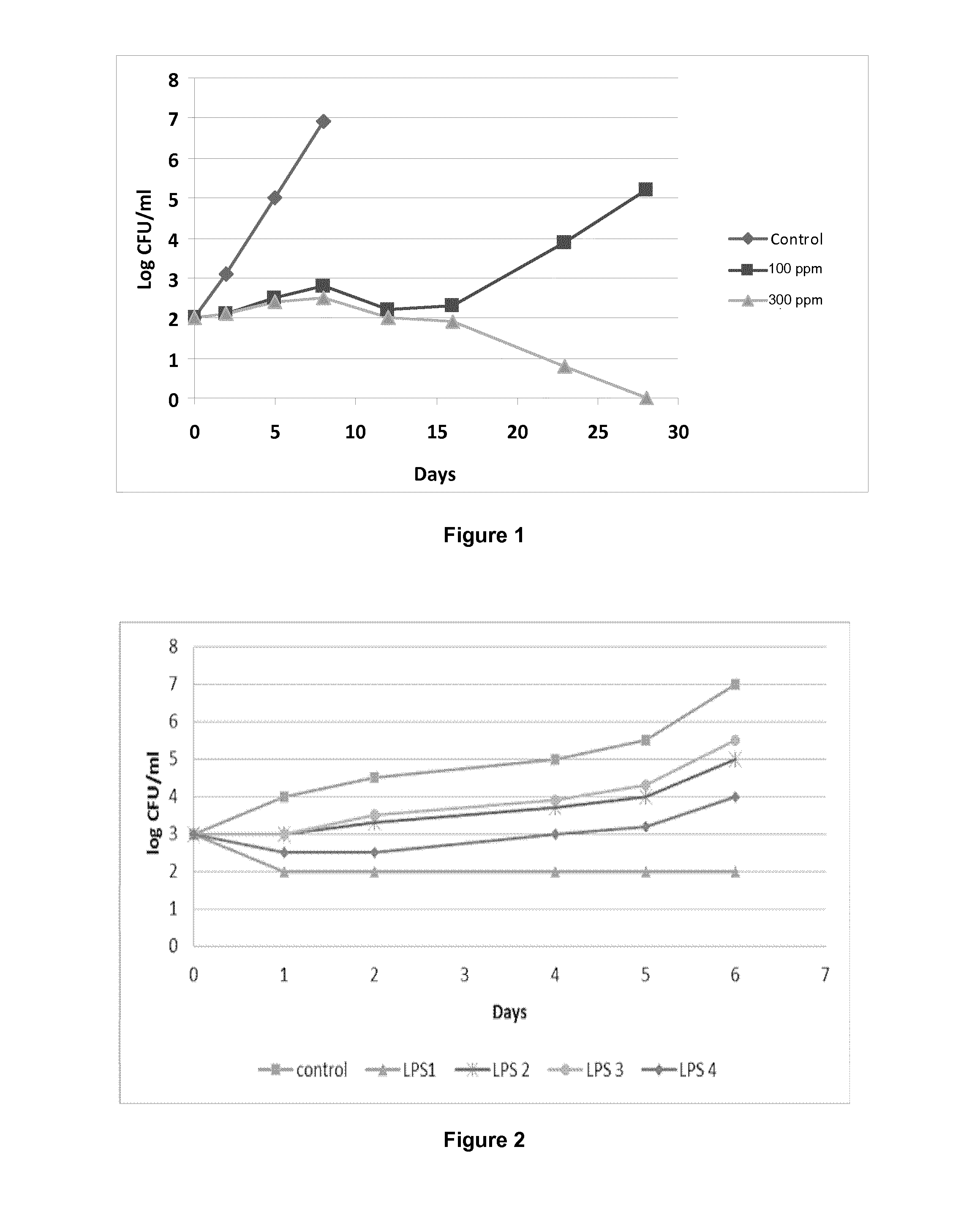Antimicrobial Compositions and Use Thereof in Food Preservation
a technology of antimicrobial compositions and compositions, applied in the field of antimicrobial compositions, can solve the problems of undetermined, spoilage by decay, unwanted microbial proliferation in food, etc., and achieve the effect of increasing the synergistic
- Summary
- Abstract
- Description
- Claims
- Application Information
AI Technical Summary
Benefits of technology
Problems solved by technology
Method used
Image
Examples
example 1
Antilisterial Activity of LPS in Milk
Experimental Design
[0122]Based on challenge tests at constant temperature (7° C.), the antilisterial effect of the lactoperoxidase system according to an embodiment of the invention was evaluated. The challenge tests were performed according to the ‘Technical guidance document on shelf-life studies for Listeria monocytogenes in ready-to-eat foods’ (EU CRL Listeria, november 2008) by the BELAC accreditated laboratory (accreditation certificate n° 059-TEST). Tests were executed in UHT milk which was aseptically divided into smaller portions and inoculated with a cocktail of L. monocytogenes strains (LMG 23194, LFMFP 392 and LFMFP 491) at an inoculation level of approximately 50 CFU / ml. The LPS product was added to the milk in different concentrations (0, 100 and 300 ppm). Samples were analyzed on day 0 (before and after inoculation) and at different days during storage at 7° C. The challenge tests were performed in threefold.
[0123]The used LPS prod...
example 2
Antimicrobial Activity of LPS in Semi-Skimmed Milk Inoculated with Lactobacillus brevis
[0127]Lactobacillus brevis is a very well-known micro-organism responsible for the microbial spoilage of milk and many other food products. Semi-skimmed milk was inoculated with Lactobacillus brevis in a challenge test, according to the protocol below.
Experimental Design
[0128]Materials[0129]Lactobacillus brevis ATCC 8287 / Disc Oxoid NLB145[0130]Semi-skimmed UHT milk[0131]Incubator 12° C.[0132]Incubator 30° C.[0133]Vortex mixer[0134]Sterile Petri dishes (9 cm);[0135]Sterile pipettes tips 100 μl:[0136]Sterile pipettes tips 1000 μl:[0137]Sterile MRS (Man, Rogosa and Sharpe) agar bottle (ready to use)[0138]PPS (pepton or trypton physiological salt solution) sterile tubes (10 ml)
[0139]METHOD
Preparation of Culture Medium
[0140]Inoculate 5 ml of semi-skimmed milk with one disc of Lactobacilus brevis; [0141]Mix the inoculated milk by vortexing[0142]Incubate overnight at 30° C. (20 h to 24 h). Mother soluti...
example 3
Antimicrobial Activity of LPS on Semi-Skimmed Milk Inoculated with Escherichia coli 0157:H7
Experimental Design
[0174]Semi-skimmed milk was inoculated with a cocktail of Escherichia coli 0157:H7 strains (LFMFP 463, LFMFP 474 and LMG 21756) at a level of 50 cfu / ml. LPS was added in different concentrations (0 ppm (=control), 100 ppm, 300 ppm). The milk was divided in portions and stored at 12° C. Analyses were performed on day 0, day 3, day 4, day 5, day 6 and day 7. The experiment was performed in threefold.
Results
[0175]Table 3 and FIG. 3 depict cell counts of Escherichia coli O157:H7 in milk during incubation at 12° C. LPS clearly suppressed the growth of a mixture of Escherichia coli O157:H7 strains inoculated in milk. At 300 ppm, no growth of the pathogen was observed after 7 days.
TABLE 3Cell counts (log cfu / ml) of Escherichia coliO157:H7 in milk during incubation at 12° C.TimeControl100 ppm300 ppm(days)12312312302.02.02.01.91.91.91.91.91.935.25.25.21.91.91.91.71.41.546.36.56.52.42...
PUM
| Property | Measurement | Unit |
|---|---|---|
| Fraction | aaaaa | aaaaa |
| Time | aaaaa | aaaaa |
| Time | aaaaa | aaaaa |
Abstract
Description
Claims
Application Information
 Login to View More
Login to View More - R&D
- Intellectual Property
- Life Sciences
- Materials
- Tech Scout
- Unparalleled Data Quality
- Higher Quality Content
- 60% Fewer Hallucinations
Browse by: Latest US Patents, China's latest patents, Technical Efficacy Thesaurus, Application Domain, Technology Topic, Popular Technical Reports.
© 2025 PatSnap. All rights reserved.Legal|Privacy policy|Modern Slavery Act Transparency Statement|Sitemap|About US| Contact US: help@patsnap.com



